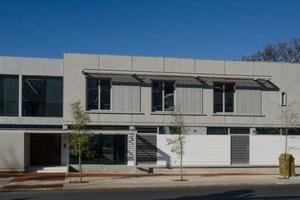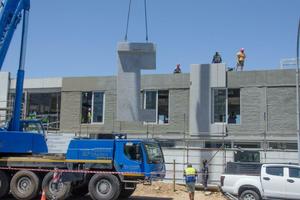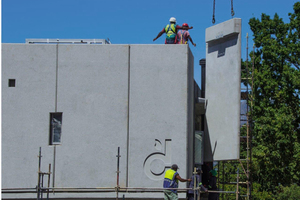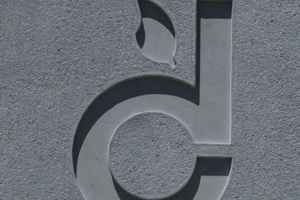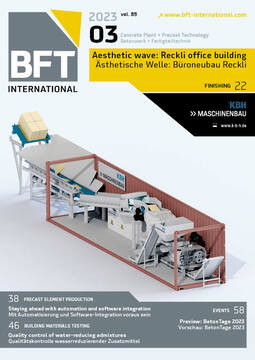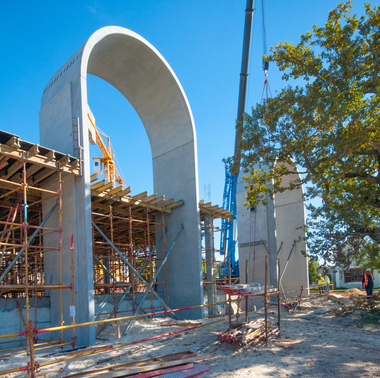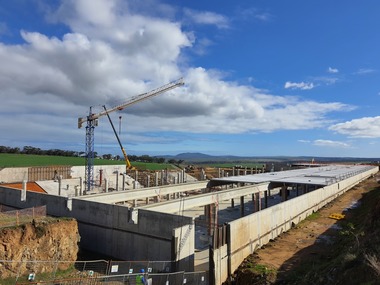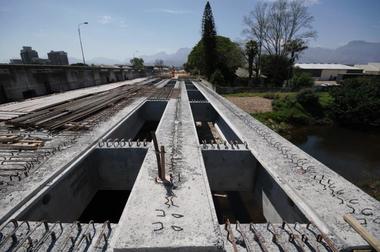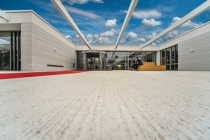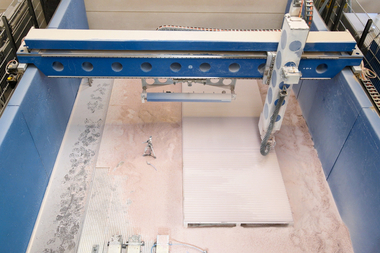Precast Panelling embellishes new Delecta Fruit HQ Building Façade in Paarl/South Africa
Textured precast concrete panelling has been used to dress the street-facing façade of new headquarter premises of fruit export company, Delecta Fruit (Pty) Ltd. Completed in March and fronting onto Paarl’s Main St, the 1,700m² building comprises two office floors and a parking basement.
Concrete Manufacturers Association member, Cape Concrete, produced 15 panels for the project. They were cast with granite aggregate and bush-hammered for a textured finish.
“Delecta decided on a textured precast concrete façade due to the manner in which this finish and a traditional lime-washed finish, as seen on the Cape Dutch buildings in the area, interact with sunlight,” said the building’s architect, Gideon Malherbe of Malherbe Rust Architects. “Moreover, the colour of the concrete and the aggregate were chosen on the basis of their similarity to Paarl Granite.
“The building is located on what was one of the last undeveloped plots along Main Road and the site falls within the Paarl Central Special Character Protected Area Overlay zone. This and the fact that some foundation walls of a building older than 60 years were visible above ground level, meant that the new structure’s design had be vetted by provincial and municipal heritage authorities. We were fortunate that the site falls toward the back of the property and this enabled us to install basement parking and still maintain a small street-facing façade.
“As part of our objective to break up the mass of the facade, the main set of panels appears to float across the upper-floor facade. This illusion is achieved through a ribbon of windows and aluminium cladding which runs below the main set of panels.The wall below the ribbon window is covered in a thick plaster band detail which references the plaster work of some of the older buildings on Main Street.
“Cape Concrete’s dedication to the quality and consistency of the scabbled finish delivered a very pleasing result,” said Malherbe.
Two-sided section of the ground-floor façade covered
Eleven panels were installed on the top-floor façade and four were used to cover a two-sided section of the ground-floor façade. The upper-level panels span 5.3m (height) by 2.6m (width) and are 115mm thick with a 300mm thickened beam section at the top of the panel. Abutting a 230mm brick wall, the panels provide an additional layer of thermal insulation for what is a west-facing elevation.
The ground floor panels measure 2.37m (height) and up to 5.37m (width) and cover three walls of a small annex adjacent to the entrance of the building.
Using steel shuttering, the casting was done horizontally on a tilt-up table which was adjusted to an 80º angle after 18 hours, by which time the panels had reached a strength of 20MPa. They were then lifted and stored vertically before being transported to site on A-shaped steel frames mounted on flat-bed trucks.
The upper-level façade panels were cast with a support-beam section at the top of each panel. They extend 185mm from the inner panel face and provide an inverted ledge from which the panels were hung when lowered onto the supporting in-situ beam.
Galvanised steel brackets were used ensure that the panels were permanently affixed to the in-situ beam. The right-angled brackets were first attached to the support-beams with bolts threaded into fixing anchors, which Cape Concrete had cast into the beams. Then, once the panels were accurately aligned, holes were drilled into the in-situ beam and knock-in anchors, similar to rawl bolts, were hammered through the bracket bolt holes into the in-situ beam and tightened with a spanner.
The panels were also secured at the bottom ends for added stability by galvanized angle brackets which were pre-fixed to the upper-level floor deck and two galvanised steel pockets which were cast into the bottom of each panel. As the panels were lowered into position the galvanized angle brackets were slotted into the pockets and grouted after the alignment process had been completed.
Trouble-free installation
The panels were cast with window sections as well as pockets for the attachment of timber-screened pergolas. The pergolas shade the west-facing windows from the direct sunlight during office hours. They were supported by steel I-beams, which were attached to the superstructure through panel pockets.
After being lowered into position, the ground-floor panels were temporarily supported by push-pull props while they were permanently secured to a steel I beam along the top ends with cast-in fixing anchors and galvanised steel pockets at the bottom ends.
Cape Concrete director, Johan Nel, said that some of the panels had to be cast with mitered ends for corner installations and that one of the panels was cast with an embedded Delecta logo which required the fabrication of special moulding.
“The project required great accuracy during casting to ensure the required level of precision in the installation of the panels. Extensive planning had to be undertaken to make sure that the installation was trouble-free and the installers spent a day using as-build lines and levels to set out the placement of each panel. This enabled accurate first-time placements which only took small adjustments to achieve perfect alignments. This meant that instead of taking the planned two days to complete the installation it was done in one day,” concluded Nel.
CONTACT
Cape Concrete Works
Wimbledon Rd., Blackheath 7580
Cape Town/South Africa
+27 21905 1200

